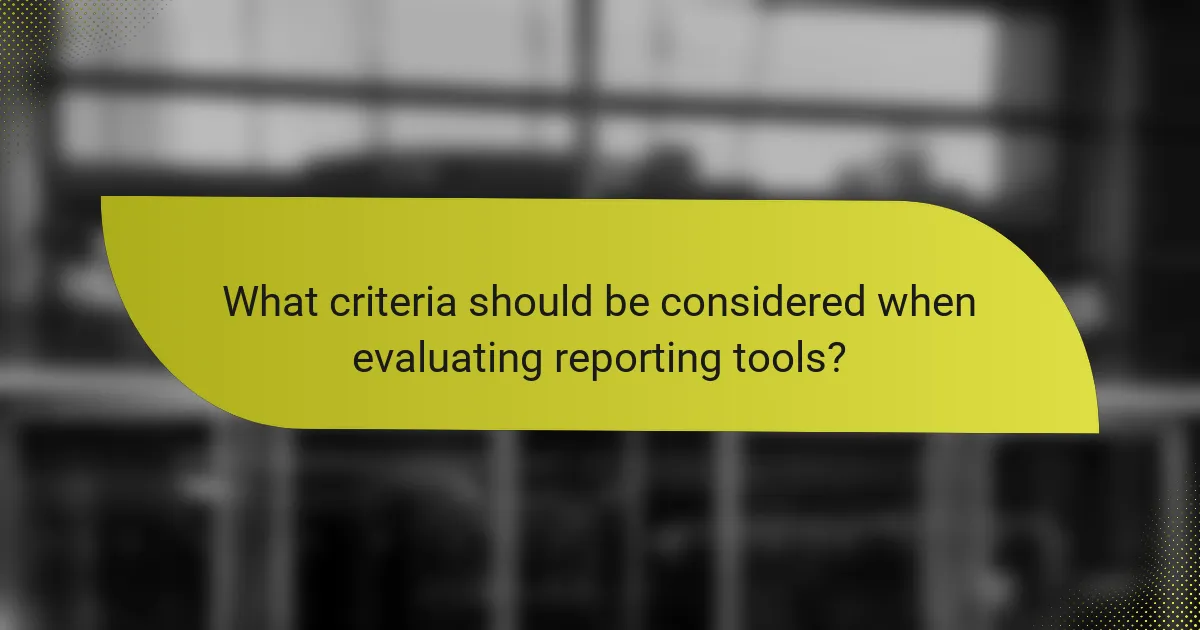Choosing the right reporting tool is crucial for effective display advertising, as it can significantly enhance insights and performance tracking. Factors such as specific business needs, data sources, and budget constraints play a vital role in the selection process. By carefully evaluating these criteria, organizations can select a tool that not only meets their analytical requirements but also aligns with their financial capabilities and strategic objectives.

What are the best reporting tools for display advertising?
The best reporting tools for display advertising include Google Analytics, Tableau, Adobe Analytics, Looker, and Microsoft Power BI. Each tool offers unique features and capabilities that can enhance your advertising insights and performance tracking.
Google Analytics
Google Analytics is a widely used tool that provides comprehensive insights into website traffic and user behavior. It allows advertisers to track the performance of display ads, measure conversions, and analyze audience demographics.
To effectively use Google Analytics for display advertising, set up goals and conversion tracking. This helps in understanding which ads drive the most valuable actions on your site. Be mindful of the learning curve; familiarizing yourself with its interface can take some time.
Tableau
Tableau is a powerful data visualization tool that helps in creating interactive and shareable dashboards. It can integrate data from various sources, making it ideal for advertisers who want to analyze performance across multiple campaigns.
When using Tableau for display advertising, focus on building clear visualizations that highlight key metrics such as click-through rates and return on ad spend. Consider utilizing its drag-and-drop interface to simplify data analysis, but ensure your data is clean and well-structured for the best results.
Adobe Analytics
Adobe Analytics offers robust analytics capabilities tailored for digital marketing, including display advertising. It provides deep insights into customer journeys and allows for advanced segmentation and attribution analysis.
To maximize Adobe Analytics, leverage its real-time reporting features and customizable dashboards. This can help you quickly identify trends and optimize campaigns. Be aware that it may require a higher budget compared to other tools, but the depth of analysis can justify the investment.
Looker
Looker is a data exploration and business intelligence platform that enables users to analyze data in real-time. It is particularly useful for advertisers looking to create customized reports and dashboards based on specific metrics.
When using Looker for display advertising, focus on its modeling layer to define metrics that matter to your campaigns. This allows for tailored insights that can drive decision-making. Keep in mind that Looker may require some technical expertise to set up effectively.
Microsoft Power BI
Microsoft Power BI is a business analytics tool that provides interactive visualizations and business intelligence capabilities. It is user-friendly and integrates well with other Microsoft products, making it a popular choice for advertisers.
To effectively use Power BI for display advertising, take advantage of its data connectors to pull in data from various sources. Create dashboards that highlight key performance indicators, and consider using its sharing features to collaborate with team members. Be cautious of data limits in the free version, as larger datasets may require a paid subscription.

How to select the right reporting tool?
Selecting the right reporting tool involves understanding your specific business needs, data sources, and user requirements. A well-chosen tool enhances data analysis, improves decision-making, and aligns with your organizational goals.
Define business objectives
Clearly outlining your business objectives is crucial when selecting a reporting tool. Determine what insights you need to drive decisions, such as sales performance, customer behavior, or operational efficiency.
Consider the key performance indicators (KPIs) that matter most to your organization. For example, if your goal is to increase sales, focus on tools that provide real-time sales data and trend analysis.
Assess data integration capabilities
Evaluate how well the reporting tool integrates with your existing data sources. A good tool should seamlessly connect with databases, CRM systems, and other applications to provide comprehensive insights.
Look for tools that support various data formats and APIs. For instance, if you use Salesforce, ensure the reporting tool can pull data directly from it without complex setups.
Evaluate user interface and experience
The user interface (UI) and overall experience of a reporting tool significantly impact its effectiveness. A clean, intuitive UI allows users to navigate easily and access the information they need quickly.
Consider tools that offer customizable dashboards and visualizations. This flexibility helps users tailor reports to their specific needs, enhancing usability and engagement.

What is the budget for reporting tools?
The budget for reporting tools varies significantly based on features, user needs, and the scale of data analysis required. Businesses should consider both initial costs and ongoing subscription fees when selecting a tool to ensure it aligns with their financial capabilities and reporting goals.
Cost of Google Analytics
Google Analytics offers a free version that is suitable for small to medium-sized businesses, providing essential tracking and reporting features. For larger enterprises, Google Analytics 360 is available, with costs typically starting in the low tens of thousands of USD annually, depending on the level of service and data volume.
When budgeting for Google Analytics, consider additional costs for training, implementation, and potential integrations with other tools. This can help maximize the effectiveness of the platform.
Pricing for Tableau
Tableau offers several pricing tiers, including Tableau Creator, Explorer, and Viewer, with costs ranging from approximately 70 to 150 USD per user per month. The choice of plan depends on the level of access and functionality required by your team.
Organizations should evaluate their reporting needs and the number of users to determine the most cost-effective plan. Additionally, consider the potential costs for training and support to ensure successful implementation.
Adobe Analytics subscription fees
Adobe Analytics does not have a standard pricing model; instead, costs are customized based on the specific needs of the business. Subscriptions typically start in the mid to high thousands of USD per year, influenced by factors such as data volume and required features.
When planning your budget for Adobe Analytics, account for the potential need for additional services such as consulting, training, and integration with other Adobe products. This comprehensive approach can enhance the tool’s value and effectiveness for your reporting needs.

How effective are reporting tools in display advertising?
Reporting tools in display advertising are highly effective for measuring and optimizing campaign performance. They provide insights into key metrics, enabling advertisers to make data-driven decisions and improve return on investment.
Impact on campaign performance
Effective reporting tools can significantly enhance campaign performance by tracking metrics such as click-through rates, conversion rates, and impressions. By analyzing these metrics, advertisers can identify which ads perform best and allocate budgets accordingly.
For instance, if a particular ad shows a high conversion rate, reallocating more budget to that ad can lead to increased sales. Conversely, underperforming ads can be adjusted or paused to optimize overall campaign effectiveness.
Data accuracy and reliability
Data accuracy is crucial for making informed decisions in display advertising. Reliable reporting tools ensure that the data collected is precise and reflects actual user interactions. This accuracy helps in building trust in the insights derived from the reports.
To maintain data integrity, it is essential to regularly audit the reporting tools and ensure they are properly integrated with ad platforms. Inaccurate data can lead to misguided strategies and wasted budgets.
User satisfaction ratings
User satisfaction ratings for reporting tools often reflect their ease of use and the quality of insights provided. Tools that offer intuitive interfaces and customizable reporting options tend to receive higher satisfaction scores.
When selecting a reporting tool, consider user reviews and ratings to gauge overall satisfaction. A tool that is well-rated for user experience can save time and enhance the effectiveness of advertising efforts.

What criteria should be considered when evaluating reporting tools?
When evaluating reporting tools, consider factors such as scalability, customization options, user-friendliness, and integration capabilities. These criteria will help ensure the tool meets your organization’s needs and can adapt to changing requirements.
Scalability of the tool
Scalability refers to the tool’s ability to handle increasing amounts of data and users without compromising performance. A scalable reporting tool can grow alongside your organization, accommodating more complex reporting needs as your data volume expands.
When assessing scalability, look for features such as cloud-based solutions that can easily adjust resources based on demand. Additionally, consider whether the tool can support multiple users and large datasets efficiently, as this will impact its long-term viability.
Customization options available
Customization options allow users to tailor the reporting tool to their specific needs, enhancing usability and relevance. A good reporting tool should offer flexibility in report design, data visualization, and filtering capabilities.
Evaluate the extent of customization available, including the ability to create custom dashboards, modify templates, and integrate with other software. Tools that support user-defined metrics and KPIs can provide more meaningful insights tailored to your business objectives.

What are the emerging trends in reporting tools?
Emerging trends in reporting tools focus on enhanced data visualization, automation, and integration of advanced technologies like AI and machine learning. These innovations aim to improve the efficiency and effectiveness of data analysis, making insights more accessible and actionable for businesses.
AI and machine learning integration
AI and machine learning are increasingly being integrated into reporting tools to automate data analysis and generate insights. These technologies can identify patterns and anomalies in large datasets, enabling users to make informed decisions quickly.
When selecting a reporting tool with AI capabilities, consider the tool’s ability to learn from historical data and adapt to new information. Look for features such as predictive analytics, natural language processing, and automated reporting to enhance your data-driven strategies.
Common pitfalls include over-reliance on automated insights without human oversight. Ensure that your team understands the underlying data and algorithms to validate the findings and avoid potential biases in AI-generated reports.
